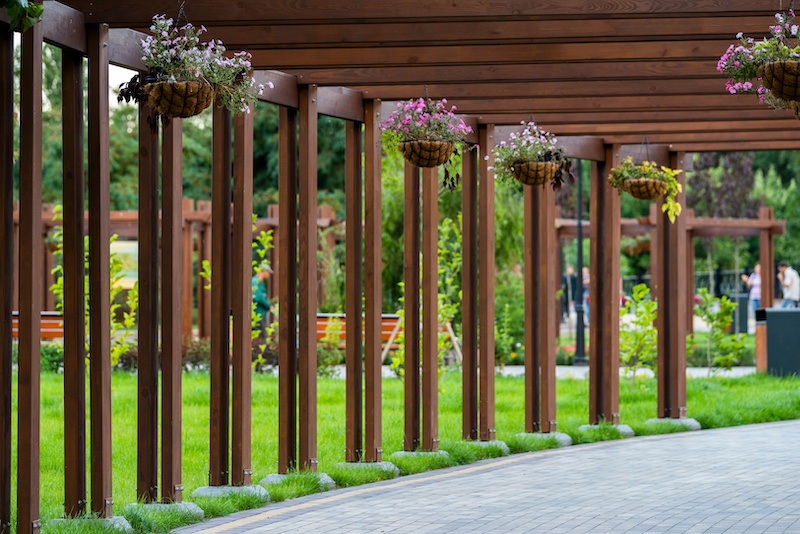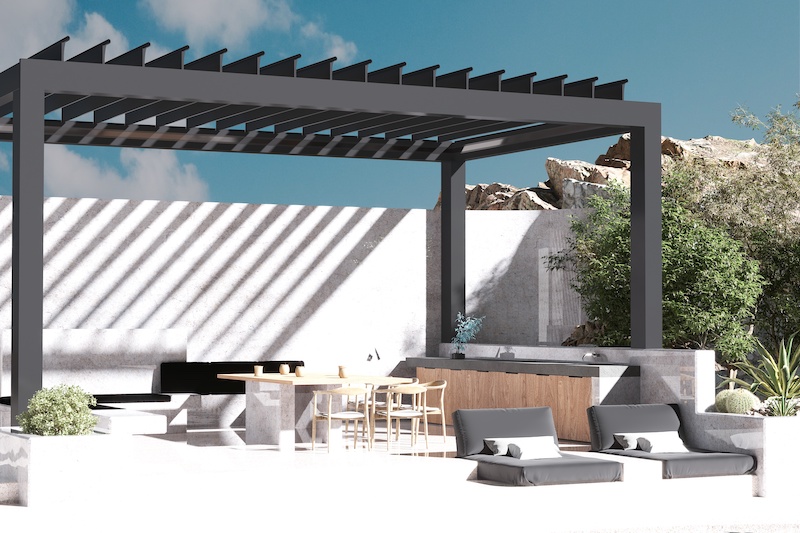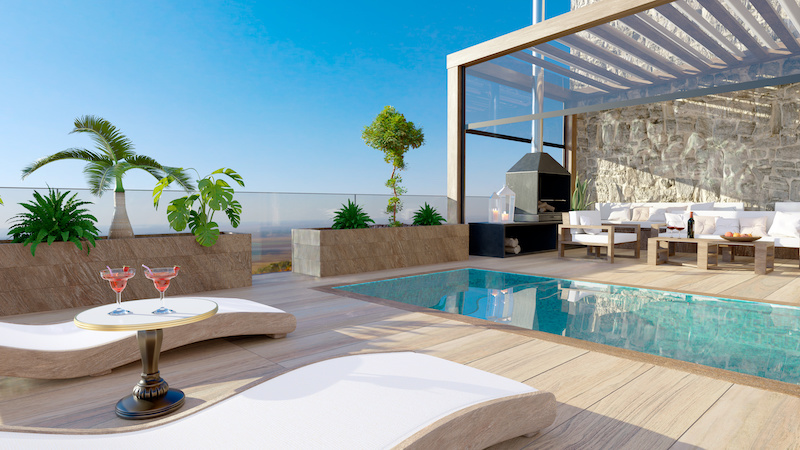Ever wondered about the history of pergolas? This architectural beauty, a garden’s crowning glory, has an intriguing past. Imagine strolling under ancient Egyptian wrought iron structures adorned with grape vines.
Pergolas have graced gardens since antiquity, offering green shade and climbing plants to high court officials in Egypt or lending charm to Renaissance gardens. From classic garden feature to modern outdoor living space – what a journey!
You’re just steps away from discovering how these beloved structures evolved over time. And there’s more! You’ll learn practical tips for building your own pergola and even uncover their role in winemaking.
The story of pergolas is far from ordinary; it’s one steeped in culture, functionality, and artistry. So stick around – this tale gets even better!
Table Of Contents:
- Origins of Pergolas in Ancient Civilizations
- Evolution of Pergolas from Renaissance Gardens to Modern Times
- The Role of Pergolas in Wine Making and Fruit Cultivation
- Modern Adaptations of Pergolas
- Utilizing Pergolas as Garden Features and Outdoor Living Spaces
- Design and Construction Techniques for Building a Pergola
- FAQs in Relation to the History of Pergolas
- Conclusion
Origins of Pergolas in Ancient Civilizations
The history of pergolas is as intriguing as their elegant design. Rooted deep within ancient civilizations, they’ve provided shade and beauty for over 3,000 years.
The Role of Pergolas in Ancient Egypt
In the scorching Egyptian climate, pergolas served a practical purpose – providing much-needed green shade. High-ranking officials often used these garden structures to flaunt their wealth and status. The earliest known garden pergola dates back to around 1400 BC and belonged to an Egyptian high court official. Constructed primarily from sandstone and wood, these early pergolas were vital components of classic gardens.
Egyptians cherished this oasis-like setting that became synonymous with social gatherings among loved ones.
Influence of Roman Architecture on Pergola Design
Moving forward several centuries into Ancient Rome, we see a new chapter unfold in our journey through the long history of pergolas. Romans borrowed heavily from Greek architecture but incorporated some unique features into their designs.
Roman aristocrats favored elaborate designs featuring climbing grape vines which added luxury to outdoor living spaces and allowed families to dine al fresco without succumbing to heatstroke.
One example worth mentioning here is how Romans developed more durable materials like wrought iron for constructing sturdier pergola structures. This material was aesthetically pleasing yet capable enough to support heavier loads such as fruit trees or hanging gardens that sometimes adorned them.
This fusion between functionality and style propelled the popularity growth of this functional structure throughout Europe during Renaissance times, where it evolved further into the garden feature that we’re more familiar with today.
As you can see, the journey of pergolas from their humble beginnings to being a prominent part of modern outdoor living spaces is fascinating and speaks volumes about our desire for beautiful yet practical solutions in architecture.
Tracing back over 3,000 years, pergolas started as functional and status symbols in ancient Egypt, providing much-needed shade with their iron or wood structures. The design evolved under Roman influence to include more durable materials and ornate features for outdoor living. This mix of style and function has elevated the pergola from a humble garden structure to an iconic element of modern architectural design.
Evolution of Pergolas from Renaissance Gardens to Modern Times
The Italian Renaissance, a period of intense cultural and artistic growth, brought about a new appreciation for garden design. One element that gained popularity during this era was the pergola. Traditionally constructed from brick, stone, or wood, these structures were adorned with climbing plants providing green shade and cool retreats.
One renowned example is the pergola at Trinita dei Monti in Rome. Overlooking the cityscape, it stood as an iconic feature reflecting Italian elegance while serving functional purposes such as creating outdoor living spaces within grand gardens.
Renaissance gardens often featured classic elements like statuesque columns supporting projecting eaves known as ledger boards – vital parts of pergolas then and now – giving them their unique charm. But even more than aesthetic appeal was their ability to support flowering plants like grape vines turning, simple walkways into beautiful corridors teeming with nature’s bounty.
Charles VIII’s Hanging Gardens: A Testament to Garden Design Innovation
King Charles VIII’s hanging gardens are another prominent example where pergolas played significant roles in garden architecture. This French king took inspiration from his travels across Italy, bringing back not only artworks but also ideas on innovative gardening styles including the use of wrought iron structures instead of traditional wooden ones, enhancing both durability and style.
The introduction of this switch marked a shift in the materials used to construct pergolas, resulting in more diverse options for modern designs. People can now choose between rustic or contemporary styles based on their personal preferences and the existing architecture of their homes. This not only enhances the overall appearance of properties but also creates functional outdoor spaces for relaxation and entertainment.
From Naturalistic Gardening to Modern Pergolas
The 19th century saw a shift towards naturalistic gardening, which again transformed pergola design. Renowned garden designers of the era were fond of incorporating them into their layouts as popular garden features offering shade and supporting climbing vines like roses, jasmine, and wisteria adding aesthetic appeal while serving practical uses too.
However, in modern times, their functionality has expanded beyond just being support structures for plants. Now they serve various other roles as well, which we shall discuss going forward.

From Renaissance Italy’s elegant gardens to modern outdoor living spaces, pergolas have evolved significantly. Originally built with brick, stone, or wood and adorned with plants for shade and beauty, they’ve adapted over centuries to incorporate materials like wrought iron for durability and style. Their purpose has also grown from simple plant supports to creating versatile functional areas in our yards.
The Role of Pergolas in Wine Making and Fruit Cultivation
Pergolas have long been entwined with the art of winemaking. In fact, pergolas and grape vines share a symbiotic relationship that dates back centuries. This garden structure provides an ideal environment for growing grapes used in wine production.
Historically, these outdoor structures served as hanging gardens for fruit trees such as figs. The overhanging berries grew lush under the green shade provided by pergola roofs. It’s no wonder why they were popular garden features amongst high court officials in ancient civilizations.
In modern vineyards today, you’ll still see this classic garden feature housing rows upon rows of grape vines.
Ancient Wine-Making Techniques Under Pergolas
Pergolas began their journey providing shade but soon found their place supporting fruitful vegetation like grapevines. The Latin word ‘pergula’ refers to a projecting eave which essentially is what these roof-supported structures are designed as – extended covering walkways aiding cultivation and growth.
This functional structure created an ideal living space for climbers like grapevines due to its design offering both support and exposure necessary for optimum yield; something not lost on our ancestors who recognized this unique benefit early on.
Growing Figs and Overhanging Berries Using Modern Pergolas
Modern pergolas also play an essential role when it comes to cultivating fruits other than grapes. For instance, consider house figs: when grown against the ledger board of a freestanding pergola, they offer not just aesthetic pleasure but also delicious and healthy fruit.
With the right garden plan in place, your pergola can turn into a lush living space filled with flowering plants and overhanging berries. But remember to take good care of your outdoor structures. Start the conversation about maintaining your own backyard beautification project today.
Pergolas, historically intertwined with wine making and fruit cultivation, continue to offer the perfect environment for growing grapes and other fruits like figs. This age-old garden feature supports fruitful vegetation while also creating beautiful outdoor spaces. To ensure your pergola stays lush, remember regular maintenance is key.
Modern Adaptations of Pergolas
The charm and utility of pergolas have persisted through the ages, but their designs have continually evolved. Today’s modern adaptations of pergolas beautifully blend functionality with aesthetics.
One notable innovation is the integration of wrought iron in urban exteriors. Wrought iron pergolas, a departure from traditional wood or stone structures, offer an appealing contrast to soft garden features while providing durable support for climbing plants.
Pergola design has also been adapted to enhance outdoor spaces in our homes. They now serve as extensions of living areas into gardens and patios, often featuring dining sets or lounging furniture beneath their shade-providing canopy.
This adaptation isn’t just about adding beauty; it’s also about maximizing space usage in smaller yards common to urban settings. These multi-purpose structures allow homeowners to enjoy open-air relaxation without sacrificing comfort or convenience.

Creating Functional Living Spaces
Incorporating a pergola can transform your backyard into an outdoor oasis perfect for entertaining loved ones or unwinding after a long day. With additions like string lights, weather-resistant curtains, and plush seating options you can create cozy retreats that rival any indoor living room.
Craftsmanship Evolved Over Time
No longer confined by classic designs built with ledger boards or beams aligned perfectly square – today’s builders are free to experiment with materials and shapes resulting in unique modern styles including circular forms.
Utilizing Pergolas as Garden Features and Outdoor Living Spaces
Pergolas have been a staple of gardens for ages, but they still remain one of the most sought-after features. With their ability to provide shade and support climbing plants like grape vines and flowering plants, they create a natural extension of your living space outdoors.
Pergolas are versatile structures that can transform an ordinary backyard into a stunning outdoor living space. A well-placed pergola provides not just functional benefits but also enhances the aesthetics of any area it occupies.
Transforming Your Backyard with a Pergola
At MG Construction & Decks, we excel at transforming simple backyards into appealing outdoor spaces with beautifully designed pergolas, among other things.
Having worked on some of the nicest homes in the region over the years, we’ve seen how adding a freestanding or attached pergola creates shaded spots perfect for lounging or dining under the green shade from climbing vines, making even scorching summers enjoyable.
Garden Plan Incorporating Pergolas
To make sure you get maximum utility out of these garden structures, consider working them into your overall ‘garden plan’. They work great as anchors, connecting different parts together and creating visual interest throughout seasons due to the ever-changing foliage cover.
Pergolas: A Canvas for Your Creativity
Modern pergolas are no longer just functional structures providing shade; they’re a canvas for your creativity. From overhanging berries and fruit trees to hanging gardens of flowers, there’s no limit to what you can achieve with them.
You can have a pergola that not only increases your outdoor living space but also elevates the beauty of your backyard. It’s a great way to enjoy nature without leaving home. And with materials like wrought iron, it becomes even more stylish and easy to maintain. So if you’re thinking about enhancing your outdoor space, consider reaching out to MG Construction & Decks for an exciting transformation.
Design and Construction Techniques for Building a Pergola
The art of building a pergola starts with choosing the right materials. Traditionally, wood was often used due to its natural charm and affordability. But today’s builders frequently opt for wrought iron because it offers durability, style, and low maintenance.
One essential component in constructing your pergola is the ledger board. This piece serves as the backbone of your structure, attaching directly to your house or freestanding in an outdoor living space.
In terms of design aesthetics, you might consider incorporating elements like climbing plants or flowering vines that will wrap around your pergola’s frame—this helps create green shade during hot summer months while adding beauty to any garden plan.
Framing Your Perfect Pergola
The construction process begins by setting sturdy posts into concrete footings for stability—a crucial step when dealing with heavy materials like wrought iron structures. Afterward comes installing cross beams on top using secure bolt connections.
To provide more functionality beyond being just a decorative garden feature though; many modern pergolas include latticed roofs supported by columns that allow climbing plants such as grapevines to weave their way up, providing both additional shade coverage as well as enhancing aesthetic appeal.
A Marriage Between Functionality & Aesthetic Appeal
Pergolas have come a long way since their humble beginnings serving the ancient Egyptians. They now function not only as stunning focal points within our gardens but also serve practical purposes, from hosting loved ones under twinkling fairy lights at dusk to providing shade, offering solace from harsh sunlight during daytime hours.
Ready To Build?
When you’re ready to embark on your pergola project, keep in mind that while DIY is an option, working with a professional team can ensure a smoother process and superior results. From designing your pergola and choosing the right materials to proper installation techniques—every detail matters when it comes to creating an outdoor oasis.
Pergolas provide a relaxing outdoor space for family gatherings, a cozy reading spot, or even an elegant venue for small events. Whether you’re adding some climbing roses to the mix or hanging twinkling fairy lights from the beams, pergolas are versatile structures that transform your backyard into something truly special.
FAQs in Relation to the History of Pergolas
What is the origin of the pergola?
Pergolas trace back to ancient Egypt and Rome, where they were used in gardens for shade and supporting plants.
When did pergolas become popular?
Pergolas gained popularity during the Italian Renaissance, enhancing gardens with their architectural charm.
What is the point of a pergola without a roof?
A roofless pergola lets sunlight through while still offering some shade. It also supports climbing plants, creating natural cover.
What is the meaning of pergola design?
The design of a pergola combines aesthetics and function—providing outdoor space with structure, beauty, and often plant support.
Conclusion
Delving into the history of pergolas, we journeyed from ancient Egypt to modern homes. We saw how these structures, once used by high court officials for shade and charm, have evolved over centuries.
We discovered the artistry in building a pergola – be it with wrought iron or wood. It’s more than just an outdoor structure; it’s a testament to design evolution that blends functionality and aesthetics.
We learned about their role in winemaking, as grape vines thrived on them in vineyards. And let’s not forget how they serve as beautiful garden features today!
In essence, understanding this history lets us appreciate our own backyard havens even more! So go ahead – relish your outdoor living space under your pergola’s comforting green shade.
Beyond pergolas, at MG Construction and Decks, we pride ourselves on our craftsmanship and versatility. Our services include deck building, pools, interior remodeling, and more. Contact us today for a free consultation.

